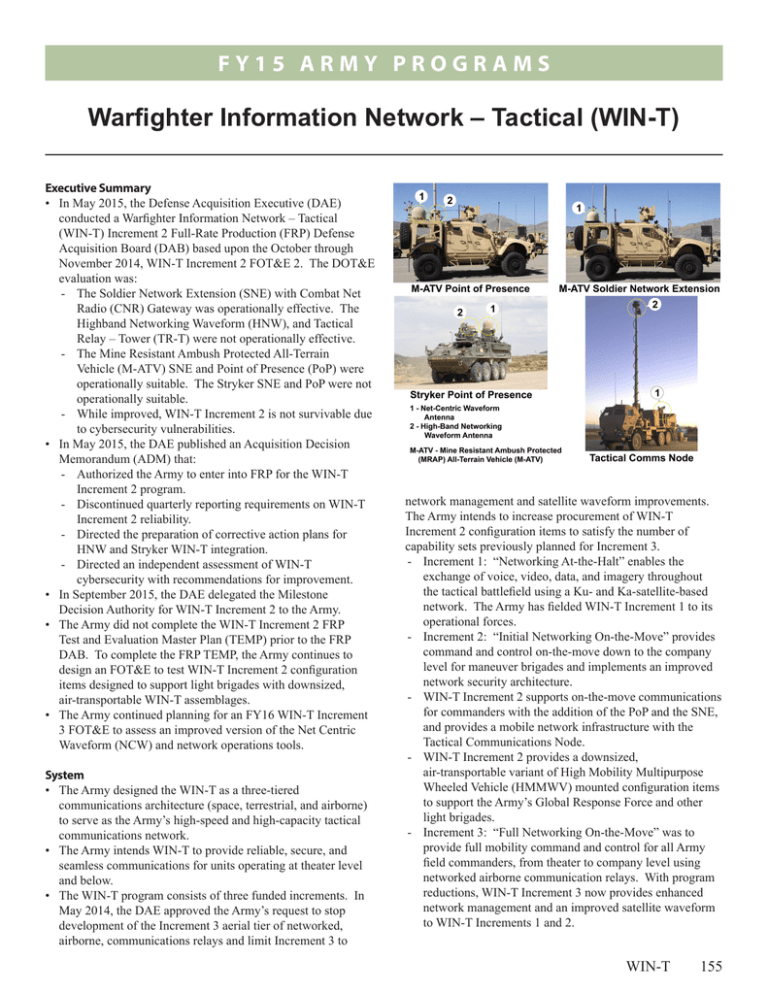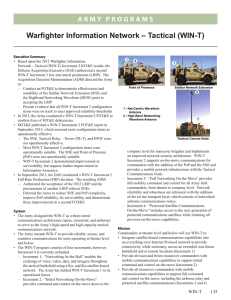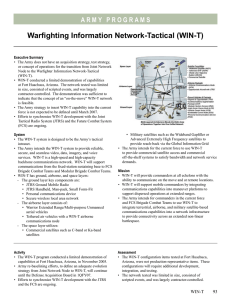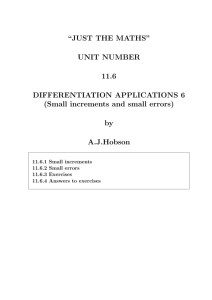Warfighter Information Network – Tactical (WIN-T)
advertisement

FY15 ARMY PROGRAMS Warfighter Information Network – Tactical (WIN-T) Executive Summary • In May 2015, the Defense Acquisition Executive (DAE) conducted a Warfighter Information Network – Tactical (WIN-T) Increment 2 Full-Rate Production (FRP) Defense Acquisition Board (DAB) based upon the October through November 2014, WIN-T Increment 2 FOT&E 2. The DOT&E evaluation was: - The Soldier Network Extension (SNE) with Combat Net Radio (CNR) Gateway was operationally effective. The Highband Networking Waveform (HNW), and Tactical Relay – Tower (TR-T) were not operationally effective. - The Mine Resistant Ambush Protected All-Terrain Vehicle (M-ATV) SNE and Point of Presence (PoP) were operationally suitable. The Stryker SNE and PoP were not operationally suitable. - While improved, WIN-T Increment 2 is not survivable due to cybersecurity vulnerabilities. • In May 2015, the DAE published an Acquisition Decision Memorandum (ADM) that: - Authorized the Army to enter into FRP for the WIN-T Increment 2 program. - Discontinued quarterly reporting requirements on WIN-T Increment 2 reliability. - Directed the preparation of corrective action plans for HNW and Stryker WIN-T integration. - Directed an independent assessment of WIN-T cybersecurity with recommendations for improvement. • In September 2015, the DAE delegated the Milestone Decision Authority for WIN-T Increment 2 to the Army. • The Army did not complete the WIN-T Increment 2 FRP Test and Evaluation Master Plan (TEMP) prior to the FRP DAB. To complete the FRP TEMP, the Army continues to design an FOT&E to test WIN-T Increment 2 configuration items designed to support light brigades with downsized, air-transportable WIN-T assemblages. • The Army continued planning for an FY16 WIN-T Increment 3 FOT&E to assess an improved version of the Net Centric Waveform (NCW) and network operations tools. System • The Army designed the WIN-T as a three-tiered communications architecture (space, terrestrial, and airborne) to serve as the Army’s high-speed and high-capacity tactical communications network. • The Army intends WIN-T to provide reliable, secure, and seamless communications for units operating at theater level and below. • The WIN-T program consists of three funded increments. In May 2014, the DAE approved the Army’s request to stop development of the Increment 3 aerial tier of networked, airborne, communications relays and limit Increment 3 to network management and satellite waveform improvements. The Army intends to increase procurement of WIN-T Increment 2 configuration items to satisfy the number of capability sets previously planned for Increment 3. - Increment 1: “Networking At-the-Halt” enables the exchange of voice, video, data, and imagery throughout the tactical battlefield using a Ku- and Ka-satellite-based network. The Army has fielded WIN-T Increment 1 to its operational forces. - Increment 2: “Initial Networking On-the-Move” provides command and control on-the-move down to the company level for maneuver brigades and implements an improved network security architecture. - WIN-T Increment 2 supports on-the-move communications for commanders with the addition of the PoP and the SNE, and provides a mobile network infrastructure with the Tactical Communications Node. - WIN-T Increment 2 provides a downsized, air‑transportable variant of High Mobility Multipurpose Wheeled Vehicle (HMMWV) mounted configuration items to support the Army’s Global Response Force and other light brigades. - Increment 3: “Full Networking On-the-Move” was to provide full mobility command and control for all Army field commanders, from theater to company level using networked airborne communication relays. With program reductions, WIN-T Increment 3 now provides enhanced network management and an improved satellite waveform to WIN-T Increments 1 and 2. WIN-T 155 FY15 ARMY PROGRAMS Mission Commanders at theater level and below will use WIN-T to: • Integrate satellite-based communications capabilities into an everything-over-Internet Protocol network to provide connectivity, while stationary, across an extended, non-linear battlefield and at remote locations (Increment 1) • Provide division and below maneuver commanders with mobile communications capabilities to support initial command and control on-the-move (Increment 2) Activity • In response to a September 2013 DAB, the Army conducted the WIN-T Increment 2 FOT&E 2 from October through November 2014, as part of Network Integration Evaluation (NIE) 15.1. The test employed the 2nd Brigade, 1st Armored Division using WIN-T Increment 2 under operationally realistic conditions at Fort Bliss, Texas, and White Sands Missile Range, New Mexico. The WIN-T Increment 2 FOT&E 2 assessed deficiencies noted during FOT&E 1, and assessed the integration of SNE and PoP configuration items into Stryker vehicles. • In May 2015, DOT&E published a WIN-T Increment 2 FOT&E 2 report to support a May 2015, FRP DAB. • In May 2015, the DAE conducted a WIN-T Increment 2 FRP DAB. The resulting ADM: - Authorized the Army to enter into FRP for the WIN-T Increment 2 program. - Authorized closure of the program’s requirement to provide quarterly progress reports on reliability. - Directed the Army to submit by June 30, 2015, a corrective action plan that addresses Stryker integration issues and improvements to network operations tools and training to optimize performance of HNW, TR-T, and Range Throughput Extension Kit (RTEK). The Army met this submission requirement. - Directed the Army to provide an independent cyber design and implementation assessment by September 30, 2015, that identifies program cybersecurity vulnerabilities and corrective action recommendations for future implementation. The Army completed this requirement and forwarded the results to the DAE on October 30, 2015. • The Army did not complete the WIN-T Increment 2 FRP TEMP prior to the FRP DAB. To complete the FRP TEMP, the Army continues to design an FOT&E to test WIN-T Increment 2 configuration items designed to support light brigades with downsized, air-transportable WIN-T assemblages. • WIN-T Increment 3 continued to design an FOT&E for NIE 16.2 to test an improved NCW and enhanced network operations tools that will be fielded to WIN-T Increments 1 and 2 units. • In September 2015, the DAE delegated the Milestone Decision Authority for WIN-T Increment 2 to the Army, designating the program Acquisition Category 1C. Assessment • In the May 2015 WIN-T Increment 2 FOT&E 2 report, DOT&E assessed the following: - The SNE with CNR Gateway was operationally effective, providing a means to bridge dispersed radio networks and link mission command applications across the brigade area of operations. - The PoP, SNE, and CNR Gateway provided improved performance for Soldiers which included: ▪▪ An improved user interface that allows an intuitive, easy-to-use method for operations and troubleshooting. ▪▪ Improved support for chat and voice communications. - The Net Centric Waveform was operationally effective, providing a stable satellite network to support WIN-T communications. - The HNW and TR-T were not effective due to limited transmission range and throughput for on-the-move links, poor quality at-the-halt links, inability to maintain a non-fragmented network in the absence of satellite, lack of use of the RTEK, and poor network operations tools. - The M-ATV PoP and SNE were operationally suitable and met their reliability requirements. - The Stryker PoP and SNE were not operationally suitable due to poor integration of WIN-T Increment 2 equipment that interfered with the Soldiers’ performance of mission to include: ▪▪ Displays in front of the gunner’s position ▪▪ Antennas that prevent 360-degree gun coverage ▪▪ Operations with the engine off that drains batteries to the point of replacement ▪▪ Operating with the Stryker running to support WIN-T does not allow “Silent Watch” operations - The Stryker PoP met its reliability requirement, while the Stryker SNE did not. - WIN-T Increment 2 is not survivable. Although improved, WIN-T Increment 2 continues to demonstrate cybersecurity vulnerabilities. This is a complex challenge for the Army since WIN-T is dependent upon the cyber defense capabilities of all mission command systems connected to the network. - Improved reliability that met reliability requirements for the M-ATV PoP and SNE, and the Stryker PoP. The 156 WIN-T Major Contractor General Dynamics, C4 Systems – Taunton, Massachusetts FY15 ARMY PROGRAMS Stryker SNE did not meet its reliability requirement, but was borderline. • WIN-T Increment 2 provides HMMWV mounted configuration items to support the Army’s Global Response Force and other light brigades. The Army’s WIN-T Increment 2 FOT&E planning for this configuration set has focused on the Tactical Communications Node – Light (TCN-L) and Network Operations and Security Center – Light (NOSC-L), but has not planned testing for the HMMWV mounted PoP and SNE (as equipped in light brigades). The HMMWV-mounted PoP and SNE have not been assessed in an operational test. This version of WIN-T Increment 2 is a significant redesign of the fielded M-ATV variants and requires an FOT&E to assess this version’s effectiveness, suitability, and survivability. Recommendations • Status of Previous Recommendations. The program addressed one of four previous recommendations. They still need to conduct the planned NCW and network operations FOT&E in FY16, plan operational testing of future integration of WIN-T Increment 2 into combat vehicles, and improve the transmission range of HNW and employment of the TR-T. • FY15 Recommendations. The Army should: 1. Improve WIN-T Increment 2 cybersecurity and assess its survivability in a future operational test. 2. Improve the employment of the HNW with TR-T and RTEK by providing tactics, techniques, and procedures with improved training and enhanced network operations tools. 3. Complete the WIN-T Increment 2 FRP TEMP. 4. Conduct an operational test to assess WIN-T Increment 2 HMMWV-mounted configuration items designed to support the Global Response Force and other light brigades. 5. Conduct an operational test to assess the improved NCW and network operations tools provided by WIN-T Increment 3. 6. Improve Stryker WIN-T integration and demonstrate these improvements in a future operational test. WIN-T 157 FY15 ARMY PROGRAMS 158










